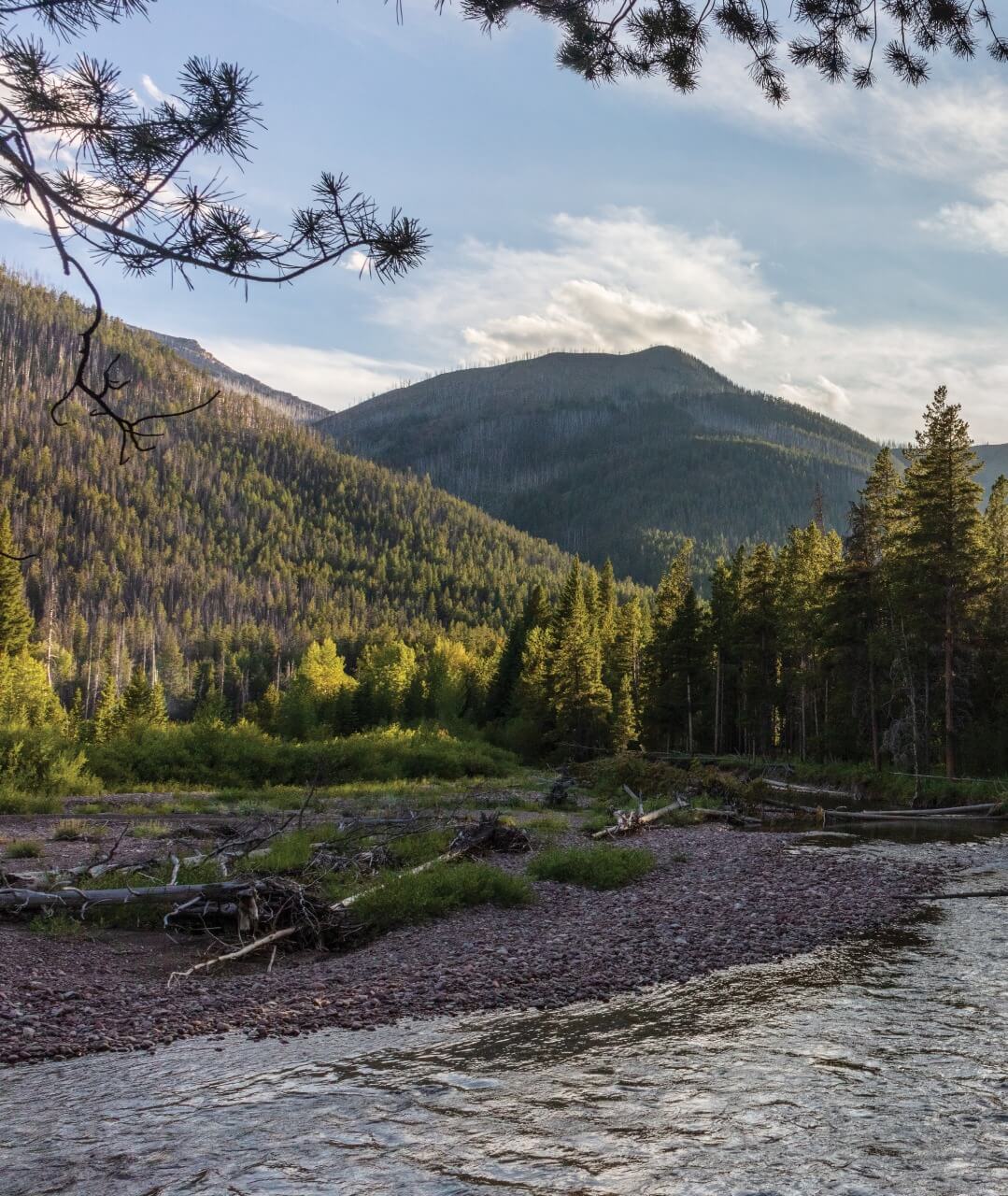
07 Jun The Covid Cure
When COVID-19 hit and shelter-in-place orders were established in early 2020, the very idea of losing my freedom to roam was nearly as unpalatable to me as catching the virus. For a few weeks, I found myself stumbling around, unsure of how to make use of all this newfound time at home and trying not to sink into a depression. Although I live in Seattle — a bustling city with easy access to the outdoors — everything was closed, and the trails were packed with other bored urban defectors.
One evening, as I was staring blankly into my laptop, I stumbled across an old email with images of an event called the Run Across The Bob (AKA RATBOB). It was from a friend, a photographer and ultra-distance runner who explained that, as opposed to a race, it’s a self-supported, 50-mile trek across Montana’s Bob Marshall Wilderness. It sparked my interest immediately.
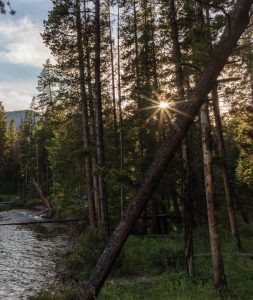
The 1.5 million-acre Bob Marshall Wilderness Complex— often referred to as “The Bob” — encompasses three congressionally designated wilderness areas in northwest Montana and was named in honor of federal forester, writer,and preservation advocate Robert Marshall. Instrumental in helping the U.S. Forest Service develop and plan policies for wilderness designation and management, he was alsoone of the founders of The Wilderness Society. When the Wilderness Act was signed into law in 1964, the Bob Marshall Wilderness was one of the first places to be protected.
In grade school — as a scrawny kid with Coke-bottle glasses — I discovered that running came easily to me, while others struggled. I joined the cross-country team in high school, but I wasn’t college scholarship material. However, it spurred a life-long running habit that’s given me a great deal of mental strength and perseverance, along with a desire to push my physical boundaries just to see how far I can go.
Looking through RATBOB photos, it hit me: This could be the perfect distraction from the pandemic blues. I emailed the event organizer and started focusing on my training plan, eager to push my limits and see a part of my home state that I’d only read about.
The Bob Marshall Wilderness Complex — or “The Bob” as it’s casually referred to — is made up of three wilderness areas that together total more than 1.5 million acres of wildlands in northwest Montana. With the Great Bear Wilderness to the north, the Scapegoat Wilderness to the south, and the Bob Marshall in the middle, the complex was named in honor of federal forester and preservation advocate Robert Marshall. It was designated a year after his death in 1940, and then officially in 1964 after the Wilderness Act was passed by Congress.
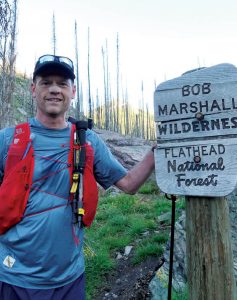
Five miles into the RATBOB, the author, Frank Field, stands by a sign marking the start of the Bob Marshall Wilderness Area.
Marshall not only helped develop policies for wilderness designation and management for the U.S. Forest Service, but he was also one of the founders of The Wilderness Society in 1935. An accomplished outdoorsman, Marshall was known to make frequent 30- to 40-mile day hikes in the 1920s and ’30s, back when fancy hydration packs, shock-absorbing footwear, carbon fiber trekking poles, energy gels, and synthetic running apparel was nonexistent. Instead, he hiked in canvas sneakers and wool pants and shirts. I figured if Marshall could traipse around that area with limited gear and no bear spray, then I could surely handle a slow 50-mile trail run.
Not long after I signed up, I added a twist to my plan: In addition to fluids and food, I would also carry a collapsible fly rod and attempt to achieve two life goals at once. I would experience The Bob and catch a westslope cutthroat trout.
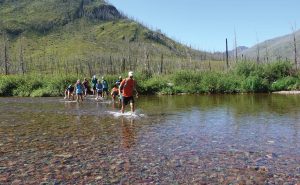
For the RATBOB participants,wading through the rivers and streams along the route helped to revive their spirits — and their soar feet.
Despite being born and raised in Montana, I grew up in a family that was not outdoorsy. When I was young, I thought the wilderness was for burly, bearded men, not skinny kids with dads who don’t hunt or fish. But I discovered fly fishing through friends and magazines, and gained a reverence for this black-spotted species. For me, it’s not just about catching fish, it’s about experiencing the places where trout live and escaping the absurdities of life. And escape was exactly what I was seeking.
That June, the day before the run, I made the 12-hour drive and set up my tent in the trailhead parking lot near Seeley Lake. By evening, about 20 other Ratbobers had gathered there. We introduced ourselves, discussed quarantine pods (small groups who would interact without COVID safety measures and only with each other) and how to keep them spread out, and talked about the route and how we’d account for everyone. When I crawled into my sleeping bag, I was filled with anticipation.
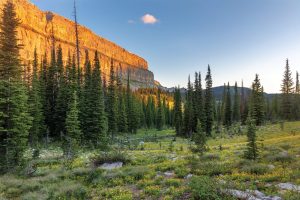
The Bob is full of surprises and natural wonders, including the Chinese Wall, a 1,000-foot-high, 12-mile-long limestone escarpment that makes up part of the Continental Divide.
I awoke to what would have been perfect marathon weather: low 50s and clear skies, though I knew temperatures would push into the 80s during our run. I could hear other runners rustling in their tents, and a few took off around 6 a.m. without even saying goodbye. I hastily tossed everything in my car and took off after them.
I was a couple of miles in and feeling strong when my left foot sank into a hole that was hidden by the morning shadows, and it aggravated an old Achilles injury. Pain shot through my leg as I limped onward and other runners passed me. I wondered if I would have to call it quits before I even reached the wilderness boundary. But I pressed on, trying to tread lightly.
Five miles in, a wooden sign announced that I’d entered the Bob Marshall Wilderness, and I felt elated for a little while. Running through a valley that was charred in recent wildfires, I followed the dusty ribbon of trail as it snaked through bright green grass that had sprung up after the fires, contrasting with the burned, scarecrow-like dead trees. The sun was high, and the air was hot. The dust kicked up by runners ahead of me made my throat dry and my eyes and nose sting. I drank water frequently to clear my throat, and the hydration pack on my back was getting noticeably lighter.
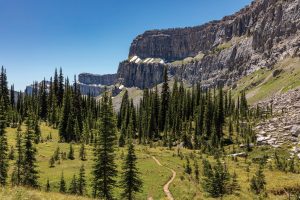
While many of the trails on the RATBOB route were well-defined, the runners had to use some guesswork in places where they crisscrossed or were covered with overgrowth.
At mile 10, Young’s Creek brought some relief, and a group of runners stood in the cold water before crossing. I had filters in my pack, but while the others discussed giardia, I decided to fill up elsewhere, assuming I’d have ample opportunities in the miles ahead.
My priorities fully misplaced, I had tied a fly on my line the night before in hopes of fishing Gordon’s Creek up ahead. I imagined the Ratbobers would be spread out by then, and I could enjoy a few quiet moments to fish. But 18 miles in, the small group I was trailing stopped where two overgrown trails crisscrossed in knee-high grass. After some discussion, we selected the one that we hoped would take us up and over Cardinal Peak.
We chose correctly, and the grueling climb ahead included substantial obstacles. First, we encountered large stands of fire-ravaged timber. Over and under burned trees we went, making slow progress. At one point, I reached for my asthma inhaler, only to discover it was empty. I shrugged and moved on. Up and up we climbed, and finally clearing the downed trees, we were greeted by a large patch of huckleberries. Social distancing went out the window as we reached for fistfuls of the juicy, purple berries, joking that the bears might get upset and retaliate.
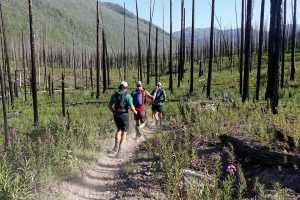
Part of the route travels through valleys that were charred by wildfires.
The runoff from melting snow had given us the huckleberries, but it also turned the next section into a quagmire. We slogged along, post-holing through deep mud. Occasionally, a runner fell or stopped to dig for a shoe that had been sucked off by the sludge.
As we continued to climb, my body slowly started rebelling. A few socially distanced meters turned into 20, then 50, 100. Occasionally, I would lose sight of other runners altogether, and I didn’t have the energy to surge and catch up. I was hot, nearly out of water, and my asthma — although mild — was hindering my breathing. Moving slowly with my weary head turned down, I noticed more and more bear scat along the trail. My thoughts began to turn dark. What if I lose the group? I don’t know these trails. What if I get lost entirely? How would I get out? How could I cross another mountain to safety? What if I encounter a bear? What if I encounter multiple bears? Was I going to die here?
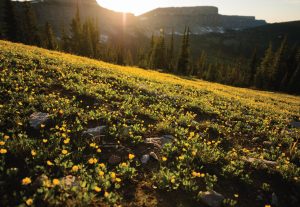
Fields full of wildflowers add to the beauty of The Bob.
Suddenly, in a clear section of trail, a woman and her partner were waiting for me, looking concerned. “You get in front of me,” the woman said. “I want to keep an eye on you.” I took out my trekking poles and leaned on them, pulling myself up the trail as they helped me along with words of encouragement and electrolyte capsules. By the time we summited Cardinal, around mile 25, the woman ran ahead, singing casually to herself. She made it look so easy, and I wondered how I’d misjudged my abilities so badly.
But her spirit lifted mine, and they continued to encourage me until I felt that I could run down the mountain on my own. I let gravity do its job, using as little effort as possible. A few miles later, near the bottom, I met up with them again, and we refilled our flasks with clear, cold spring water. I felt refreshed. I was getting a second wind.
The three of us hit the trail once again, but before long, we were bushwhacking through thick, overgrown vegetation. The bear grass was nearly as tall as me, and invasive weeds, like knapweed and toadflax, mingled with wildflowers, like white pearly everlasting and Indian paintbrush. We couldn’t see where our feet were landing, but we continued to run.
When we turned the next corner, we encountered several runners who were looking for the trail. With 20 miles to go and another mountain to climb, it was a less-than-ideal time to get lost. Several promising paths dead-ended, and, finally, a runner with a satellite map found the way. Disaster averted.
Hours later, with the sun descending in the sky, we came to Gordon Creek, our last water crossing and the spot where I’d planned to catch that westslope cutthroat trout. I stopped and looked into the clear stream, then up at the mountain that lay ahead. It was a clear choice: No fishing for me. I left the rod in my pack and soldiered on.
As I limped down the last mountain, I knew my time in The Bob was waning. I imagined that my journey was probably similar to ones that Marshall experienced in the same wilderness almost a century before, methodically taking in the sights and sounds, and not taking any fish.

After completing the grueling 50-mile trek, the author recognized that — even though he could have trained more — for him, the main accomplishment was finish-ing the RATBOB, while also witnessing a backcountry landscape that many never get to see in person.
There were no finish-line crowds when Marshall completed his marathon hikes, and there were none for the Ratbobers either. Instead, we stopped and reflected on what we’d just done in quiet awe. It felt surreal. Some of the runners had loved ones there to greet them and offer congratulations, a beer, and a campfire to warm up around. I ate a cold burrito from the cooler in my car and crawled stiffly into my tent just after sunset.
Laying there, listening to a wolf howling in the distance, my body was in too much pain to fall asleep. I’d made it, and I was proud of that, but the wilderness had also humbled me. Still, it wasn’t lost on me that I’d just experienced a place that few people get to see in person, and I’d done something that few people would attempt. And while I had grossly overestimated my abilities, I had gained self-confidence, knowing that at least I had finished. I had also witnessed something magical that I could reflect on when I was back in Seattle, stuck on Zoom meetings inside the same four walls.
I decided then and there that I would try the RATBOB again someday. But next time, I would train more and travel more slowly and carefully now that I knew what to expect. And next time I would — without a doubt — dip a fly into the water at Gordon Creek.




No Comments